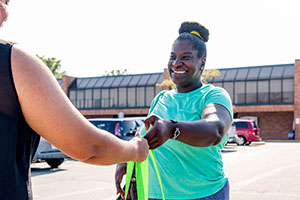Gladys Pope loves grocery shopping, so doing it for others through a delivery app has proven the perfect side hustle.
When grocery delivery became a thing, Gladys jumped on it as a source of extra income, giving up her previous side gig as an Uber driver.
“I thought, ‘Well, I like the grocery store much more than I like driving around in a car with strangers,’ the 40-year-old mom of two teenagers says. “I will spend two or three hours in the grocery store, because I’m picking and touching and reading and comparing.”
Now she earns about $1,000 a month doing these things for other people. During the week, she’s a school secretary in Cincinnati. Every Saturday and Sunday, from roughly 10 a.m. to 4 p.m., she shops for and delivers groceries through an app called Shipt.
It’s one of several startups operating in the area of food delivery. Competing apps include Instacart and store-based services such as Walmart Grocery.
Delivery is a popular side hustle, a U.S. Bank analysis found. The bank looked at total earnings deposited in customer accounts by 45 companies associated with gig work. Shipt ranked 11th on the list, depositing a total of $4 million in customer accounts during a one-year period. Instacart was 14th with $1.7 million in deposited earnings.
In the Cincinnati area, Shipt serves Meijer, Target, CVS and Petco. Customers of those stores go to the app and place their orders for delivery. Workers like Gladys then have an opportunity to select the job. Customers can’t specifically choose her each time, but if they’ve given her high ratings in the past, she’ll be automatically selected for them the next time, provided her schedule coincides with theirs.
The job includes not only finding the right items at the stores but also figuring out the customer’s desires if an item isn’t available. Gladys is able to call customers and doublecheck before making a substitution.
“It’s honestly just good customer service,” she says. “You need to be friendly, give your customers options, make it personal, go the extra step. Sometimes I have to climb on a top shelf or ask a store employee, ‘Hey, can you check the back for me?’”
Shipt gives its workers a one-hour window in which to deliver the groceries. Two hours before that window, Shipt loads money onto a credit card the worker will use to buy the items. Customers aren’t charged until the groceries are actually checked out.
Delivery people like Gladys earn a fee equal to 7% of each customer’s bill, plus $5. There’s an opportunity to earn more if demand outstrips supply in a given time period.
Tips are another part of Gladys’ business, generating about 60% of her total earnings.
“The other piece I hadn’t considered is that it’s very good for fitness,” she says. “On a typical weekend, I can walk anywhere from four to eight miles, depending on how many orders I have.”
Continue reading to learn more about how to prepare your taxes as a gig worker.











